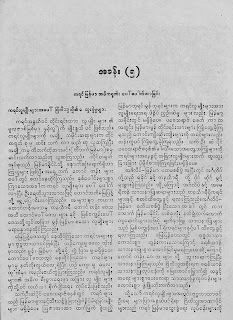In a previous post, I translated the final three pages (26, 27 and 28) of chapter 5 of the text ပြည်တွင်းသောင်းကျန်းမှုသမိုင်း (အပိုင်း-၁) (The History of Revolt within the Country - Volume 1), published by the Myanmar Ministry of Information in 1990. The chapter runs 8 pages from page 21 to page 28. The translation below covers the first page (page 21) of the chapter. The complete chapter is available in PDF form here.
Vocabulary:
သွေးခွဲ ။ to cause dissension (among friends)
အနွယ်ဝင် ။ members of the lineage
ဇာစ်မြစ် ။ origin; root; source
မြေပြန့် ။ flat land; plain
သက်ဦးဆံပိုင် ။ autocratic, despotic; absolute monarch, despot, autocrat
သီးသန့် ။ separately; reserved, special
ထက်မြက် ။ to be sharp, keen; powerful, effective
ညှဉ်းဆဲ ။ to torture; ill treat
ပဒေသရာစ် ။ feudal lord
တန်းတူ ။ to be equal
ခါးသီး ။ distasteful
နယ်ချဲ့ ။ to expand one's territory at the expense of others; expansionist
ထွန်းကား ။ to shine, light
မြေတောင်မြှောက် ။ to nurture someone to become a success
Translation:
The emergence of the Kayin-Myanmar Riots
The British cause division on the ethnic Kayin
The origin of the indigenous Kayin ethnic people is the Mon-Lweit category. Some historians are of the opinion that they descended from the Tai-Chinese group and some others are of the opinion that they descended from the Tibeto-Burmans (Tibet-Myanmar) group. The Tai-Chinese group were the last peoples to arrive in Myanmar. They started by establishing themselves on the eastern mountains. After two thousand years the Kayin ethnic peoples emerged and with the proliferation of their population they migrated to the southern plains. Many [Kayin] mixed and lived among other ethnic peoples such as Mon and Myanmar from the region of the Kayah mountain range all the way to region of the Tanintharyi mountain range in upland areas and river delta.
The majority of the Kayin resided in the plains and converted to Buddhism and their culture and tradition was not divided from the Mon and Myanmar. As for the Kayin who lived in upland areas, they worshiped spirits and culture and tradition was a little bit differentiated [from lowland peoples]. Like other ethnic peoples, the primary economic activity of the Kayin ethnic peoples was paddy agriculture.
Under the system of autocratic feudalism the Kayin ethnic peoples were not segregated from the Myanmar people and oppressed. And there was no oppression and persecution of Kayin ethnic peoples based on ethnicity by the powerful and influential Myanmar and Mon kings in Myanmar history. In accordance with the period of feudalism, Myanmar, Mon indigenous peoples experienced as equals the good effects and the bad effects that the Kayin ethnic peoples experienced. As Kayins, they did not especially experience the distasteful experiences of autocratic feudalism more than other ethnic peoples.
At the end of the first English-Myanmar war, the English annexed Rakhine and Tanintharyi. Therefore, English and American Missionaries got the opportunity for have first contact with the Tanintharyi Kayin. When the second English-Myanmar war was finished, with the expansion of [English] rule over the whole of lower Myanmar, white-faced missionaries got the opportunity to contact the Kayins in the delta. Because Buddhism was shinning well in the plains Christian Missionaries were not successful. Therefore, [they] went to the mountain regions and conducted missionary activity. The British government nurtured Christian missionary work and while giving many opportunities the missionary activities developed well.
However, with the majority of Kayin ethnic peoples being Buddhists, the British officials conducted activities to divide the Kayins and Myanmars.

0 comments:
Post a Comment